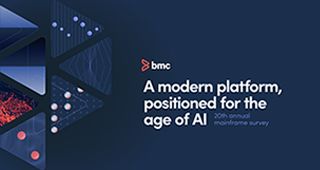What if the most powerful system in your enterprise stack—the mainframe—could finally speak for itself?
Not in some cold, robotic voice like HAL from 2001: A Space Odyssey, but as a helpful partner. A digital teammate. An intelligent collaborator that doesn’t just store history but actively shapes the future with you.
That future is no longer science fiction. It’s here—right now.
And the first thing your mainframe might say?
“How can I assist you?”
Not a command. Not a warning. A question. One that signals the beginning of a new kind of relationship—where the mainframe isn’t just processing tasks behind the scenes, but participating in decisions, conversations, and collaboration.
Welcome to a world where artificial intelligence (AI) gives the mainframe a voice—and that voice is on your side.
The most explainable platform in the AI era
As AI systems grow more powerful, they’re also becoming more mysterious. Black-box models make decisions we can’t always explain. Leaders are right to be cautious. In this AI-powered era, trust depends on transparency.
Here’s where the mainframe quietly stands apart.
It may be the oldest system in the room, but it’s also the most accountable. While newer platforms obscure their logic, your mainframe shows its work. It tracks what it did, when, and why, with provable accuracy.
And today’s mainframes are more than just battle-tested, they’re built for what’s next. With modern IBM® z16® and z17™ systems engineered to support AI workloads, data privacy, and real-time inferencing, the platform is ready to meet today’s enterprise demands with confidence.
That’s why the mainframe is emerging not just as a trusted system, but as the most explainable platform in the AI stack. It’s not just AI-compatible. It’s AI-confident.
Not HAL: A helpful assistant
Let’s set the record straight: this isn’t the silent, watchful AI you worry about. It’s not a rogue machine taking over the cockpit. It’s the opposite.
This is the mainframe asking, “How can I make your job easier?”
Through conversational interfaces and AI-augmented workflows, the mainframe is shifting from silent processor to collaborative partner. It’s not a cold, calculating system. It’s a helpful assistant, ready to diagnose, explain, recommend, and assist.
We’re not imagining a world where machines replace people. We’re stepping into one where machines support people, freeing them to focus on what they do best.
From processor to partner
The mainframe has always been there, working behind the scenes. It powered transactions, protected data, and ran critical applications day in and day out.
But the needs of the enterprise have changed.
Today, businesses move faster. Systems must be responsive, intelligent, and collaborative. And that’s exactly where the mainframe is heading.
It’s transforming from a system of record to a system of actionable intelligence where it doesn’t just store history, it interprets it. Where it doesn’t just run workloads, it optimizes them. Where it becomes a partner in decision-making, not just a passive executor.
This is a new chapter: the era of intelligent digital collaboration.
The art of the possible
Let’s get practical.
You’re facing a slow-running application. Maybe batch jobs are delayed. Maybe customer transactions are backing up. Traditionally, this would trigger middle of the night calls at 3 AM or even a war room—logs pulled, alerts analyzed, fingers crossed.
But now?
Your mainframe beats you to it. It flags the slowdown, identifies likely causes, and offers next-best actions. It might even recommend a resolution path, asking for your go-ahead to proceed.
That’s not just automation. That’s smart collaboration.
Thanks to AI agents and agentic workflows, your mainframe doesn’t just wait for instruction; it evaluates, decides, and collaborates. These agents work across operations and development, coordinating actions like digital teammates.
It’s not a stretch to compare it to self-driving cars. A few years ago, the idea felt like fantasy. Now they’re on real roads. The shift didn’t come from better tech, alone, it came from changed mindsets.
And that same shift is happening now with the mainframe. The future isn’t about control. It’s about collaboration.
Free the human
No one likes waking up to a Sev 1 outage. Time zones don’t exist when you’re processing global workloads. The system doesn’t care what time it is or how tired your team may be.
This is where AI transforms the game.
Before your war room convenes, the mainframe is already on the case. It isolates anomalies, suggests probable causes, and prioritizes next steps.
Instead of humans reacting, they’re reviewing. Instead of scrambling, they’re steering.
And this is the larger vision: free the human. Free developers to innovate. Free operators to optimize. Free architects to strategize. Let AI shoulder the weight of the mundane, so your teams can focus on the mission.
Because burnout doesn’t lead to brilliance. But AI-augmented partnership? That just might.
The expert never retires
One of the biggest risks enterprises face isn’t technical, it’s human. Decades of institutional knowledge walk out the door when your most seasoned mainframe experts move on.
Now imagine that wisdom staying behind.
With AI-powered knowledge experts, that’s exactly what happens. These systems capture, preserve, and make accessible the expertise of your most experienced team members.
Ask the mainframe:
“What does this code do?”
“How do I fix this error?”
“What caused this outage last time?”
And it answers. Not with jargon, but with natural language. Not with silence, but with guidance.
This is the future of knowledge transfer: institutional memory that never fades.
Where this is going
Let’s zoom out.
Today, your mainframe can explain unfamiliar code, detect performance issues, recommend configuration changes, and chat in plain language with your teams.
In 1 year or less, AI agents will work in teams, coordinating across applications, workflows, and even across organizational silos. They’ll learn from patterns and initiate workflows proactively.
In 2-3 years, these agents will become fully autonomous partners, handling routine remediation, performance tuning, and even compliance tasks on their own. Humans will remain in the loop, but the loop gets smarter, faster, and more strategic.
And none of this happens in isolation. The infrastructure is already here. Modern mainframe hardware like the IBM Z® series is designed for AI acceleration—with on-chip inferencing, quantum-safe encryption, and real-time processing capabilities that make this transformation not just possible, but powerful.
This isn’t unchecked automation. It’s governed intelligence, driven by policies, controls, and accountability.
We’re not talking about the distant future. We’re talking about next quarter and in the next six months.
This is the art of the possible, right now. You’ve never mainframed like this.
This isn’t science fiction, it’s a new partnership
The mainframe is talking back. Not in a monotone voice with a glowing red eye—but in your language, your context, and your mission.
It’s not here to take over. It’s here to collaborate. To help. To ask the question that signals a new kind of intelligence at work:
“How can I assist you?”
This isn’t HAL versus Dave. This isn’t about control.
This is Human + Machine, together, reshaping how work gets done.
And when the future asks how AI brought clarity, confidence, and collaboration to your enterprise, the mainframe will answer with pride:
“We did it—together.”
Learn more about how generative AI and AI agents can help bridge knowledge gaps and enhance decision making in the Modern Mainframe podcast, Closing the Mainframe Expertise Gap with GenAI and AI Agents.







